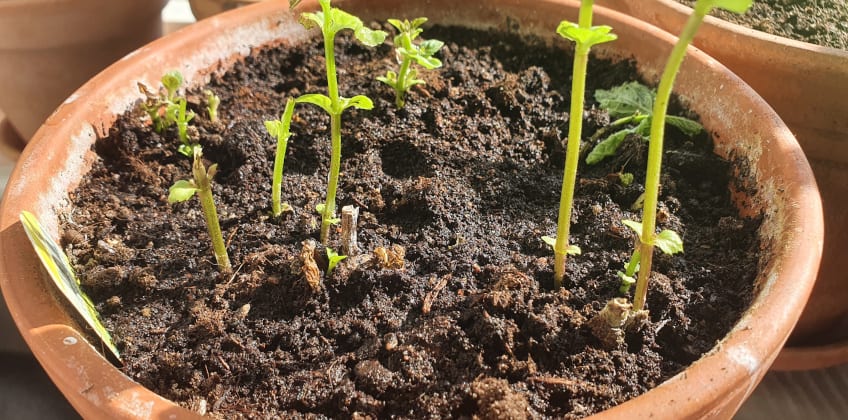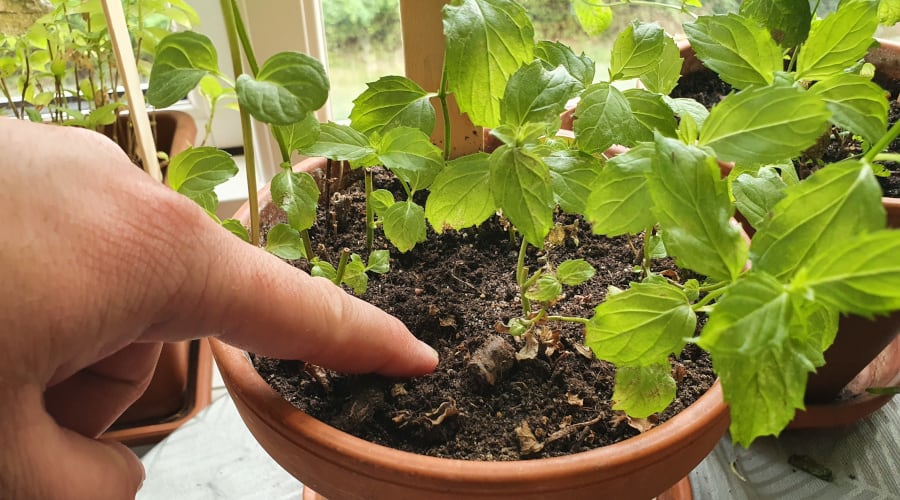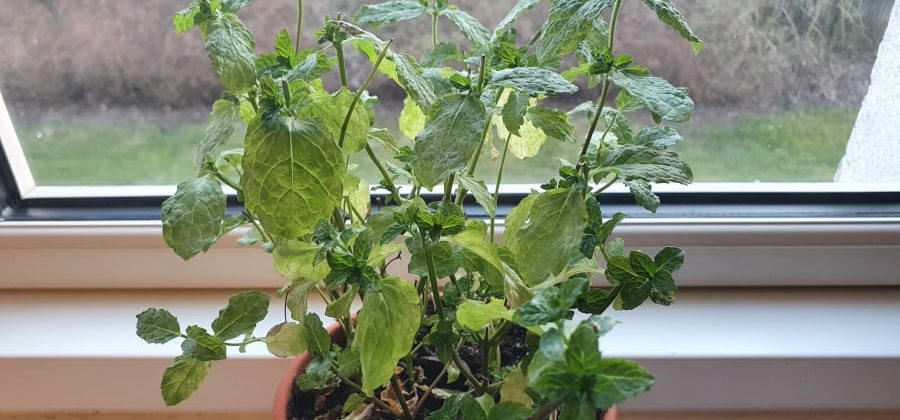This post contains affiliate links.
When I first started growing mint, I remember that one of the big things I was wondering at the time was if the plant would come back every year. Since then, I have been growing mint for many years, and I have also talked to a bunch of really skilled gardeners who shared some great tips for keeping mint alive for as long as possible.
I have written this article to teach you what I learned and to answer the question “Does mint come back every year?“. Here is a summary.
Mint plants usually come back every year. They usually go dormant in the winter and can lose most or all of their leaves depending on how cold it gets where they are grown. It can easily seem like the plant is dead, but the roots will usually still be alive and sprout new growth when it gets warmer.

Just because mint plants usually grow back doesn’t mean it is guaranteed. In fact, there are many factors that affect whether or not a mint plant will come back year after year.
In this article, I explain why mint usually (but not always) grows back and which factors affect it. I also share some tips for helping your mint grow back year after year that I have learned by growing a lot of mint and talking to a lot of excellent gardeners over the years.
Do Mint Plants Come Back Every Year?
Mint was one of the first herbs I ever grew and is still, to this day, one of my favorites. There are several reasons why I like growing mint, but one of the most important reasons is that it can grow back every year if you take good care of it.
Mint is a perennial herb which means it can grow and live for multiple years. In most parts of the world, it will usually go dormant or die back in the winter and then grow back from the roots in the spring.
You can read about how long mint plants can live and how to help them live for as long as possible on this link.
If you live in a warm area that never gets frost, you might not notice much of a difference in your plant in the winter other than that it may grow slower than in the summer.
In most of the world, however, the plant will die back and lose most of its leaves in the winter and look like it is completely dried up. This can be alarming and seem like the plant is dead, but chances are that the roots are doing just fine and will allow a bunch of new stems to come back once the temperature increases.
There are several things that can cause mint plants to not come back. For example, if you planted a young, small mint plant right before the winter, it might not survive since it is not very well-established yet. So plant your mint in the spring to increase the chance of it surviving the winter. This is just one of the things you can do to help your mint come back every year. I share a bunch more later in this article.
So if you have taken good care of your mint and it isn’t suffering from other problems, there is a very good chance it will grow back.
The thing that plays perhaps the biggest role in whether or not a mint plant comes back every year is the weather, and especially the temperature, in the area it grows in. I will get a bit more into that now.
Can Mint Plants Survive Cold Winters?
One of the things that make mint a special plant is its ability to survive the winter in most parts of the world.
Mint plants are relatively frost tolerant. The stems and leaves might dry up and die back during the winter, but the roots will usually survive since they are protected from frost by a layer of soil. If the roots survive the winter, new stems should start growing from them in the spring.
As long as the roots don’t freeze, the plant should come back in the spring. The roots will usually be just fine unless you live in an area with extremely cold winters.
Since there is no guarantee that your mint will come back every year, I thought I would share some tips that can increase the chance.
How to Help Your Mint Plants Survive the Winter (7 Tips)
Over the years, I have learned some great tricks that are simple but super effective when it comes to helping your mint survive a cold winter and come back in the spring. I have learned these tips both from growing a lot of mint myself, but especially also from talking to several really good gardeners and experts within the field.

Here are the seven tricks that I have had the most success with and why they can make such a big difference when it comes to helping mint plants survive the winter.
1. Plant your mint in the spring after the last frost
Planting your mint in the spring gives it time to grow a strong root system, which is perhaps the most important thing for your plant when it comes to surviving cold weather. You just have to make sure that there is no risk of frost before you plant it since it is still very vulnerable when it is just a seedling or a small plant.
2. Give your mint plenty of sunlight and nutrient-rich soil
Proper growing conditions are key to growing mint successfully. The better growing conditions it has, the more likely it is to make it through the winter.
Full sun or partial shade is best for growing mint. I have had the most success with full sun, but it might be a bit too much in very warm and sunny areas, so partial shade can be better.
Nutrient-rich and well-drained soil with a lot of organic matter is ideal for growing mint. You can read much more about the best growing conditions for mint on this link.
3. Use a pot that is at least 12 inches (30 cm) deep and wide
Once a mint plant becomes well-established where it was planted, it will begin to spread rapidly. If you are not careful, mint can easily take over parts of your garden that you never intended it to be in. That is why I always recommend growing your mint in a pot and not directly in the ground.
I have a guide to picking the best pot for your mint on this link, where I talk about pot size and material.
4. Remove dead growth as soon as you notice it
At some point, you will most likely notice that some of the leaves on your mint begin to turn yellow and brown and eventually die and become dry. It is a very good idea to remove these leaves as soon as possible to reduce the risk of pests and diseases.
There is usually an underlying reason why this happens to mint leaves, so if it is happening to your mint, I recommend that you read this article where I cover 11 common problems people run into when growing mint and how to solve them.
5. Use a plant cover to protect your mint in the winter
Plant covers are great for keeping a lot of pests away from your plants, but some of them are actually also great for keeping your plants warm in the winter.
Your mint plant might still lose leaves and die back in the winter if you use a plant cover, but the roots will be kept warmer than otherwise, which increases the chance they will survive until the spring, which is when new growth typically begins to appear.
6. Keep your potted mint near the house to keep it warmer
Most houses give off a bit of heat, which can help keep your mint plant, or at least its roots, warm enough to survive the winter.
7. Bottom water your potted mint to promote root growth
Bottom watering is precisely what it sounds like. Watering your plant from the bottom. More specifically, it is when you pour the water into the plate that is underneath the pot rather than directly on top of the soil.
With this method, the soil and roots soak up the water from the plate, which causes the roots to grow a bit faster than otherwise in an attempt to reach the water at the bottom of the pot. You can read more about that on this link.
Can You Still Harvest Mint in the Winter?

Mint usually goes dormant in the winter, which means it stops growing temporarily. In a lot of the world, it will even die back and lose most, if not all, of its leaves in the winter.
In some parts of the world, however, mint doesn’t necessarily die back in the winter and will still have stems and leaves that can be harvested.
I would honestly be a bit careful with harvesting mint in the winter, especially if the plant doesn’t have a lot of leaves left on it. If, on the other hand, your mint plant is thriving and still has a lot of leaves and is perhaps even still growing in the winter, I see no reason why you shouldn’t be able to harvest from it.
I have written an article with some good tips for harvesting mint in a way that makes it grow back bushier and more productive than before. You can find that article on this link.
If you, like me, live in an area with relatively cold winters, you might be interested in some tricks you can use to grow mint very successfully indoors in the winter. I share some tricks for that below.
Easy Way to Grow Mint Indoors in the Winter
You can technically grow mint indoors all year round, although you probably need some artificial grow lights for it unless you live in an area that gets a lot of sunlight in the winter.
You can get some excellent lights made specifically for supplying artificial grow lights for plants.
If you live in an area that gets several hours of sunlight per day in the winter, you can probably grow mint just fine in a pot placed in a sunny spot near a window.
Lastly, I want to say that you should probably not expect your mint to grow as fast and get as big indoors as outside unless you use grow lights. You can read more about the differences between growing mint indoors and outside here.

